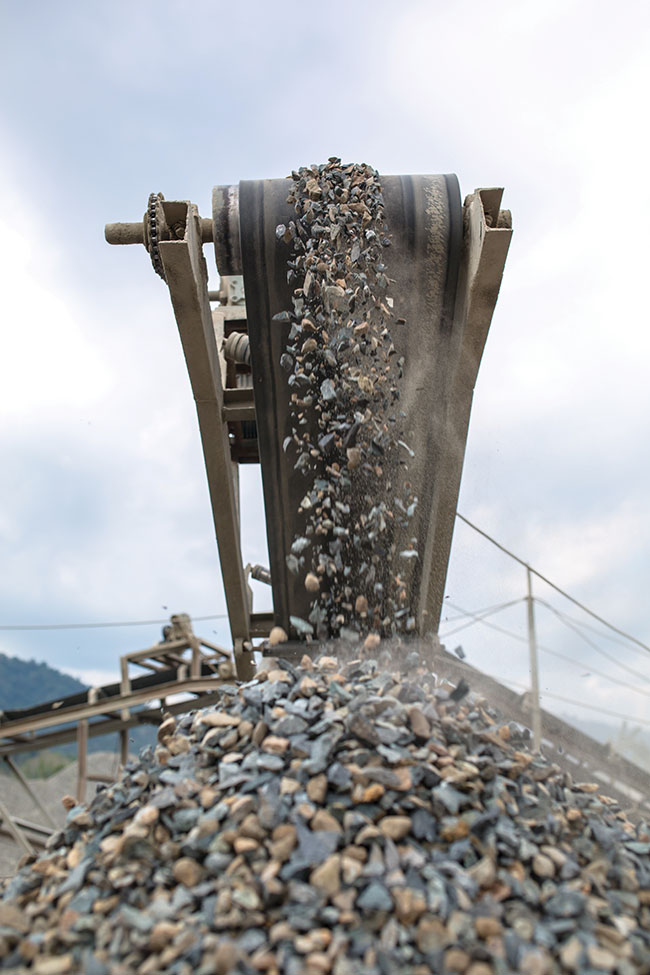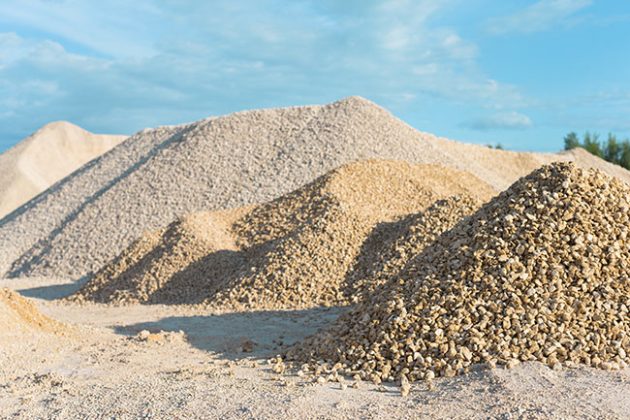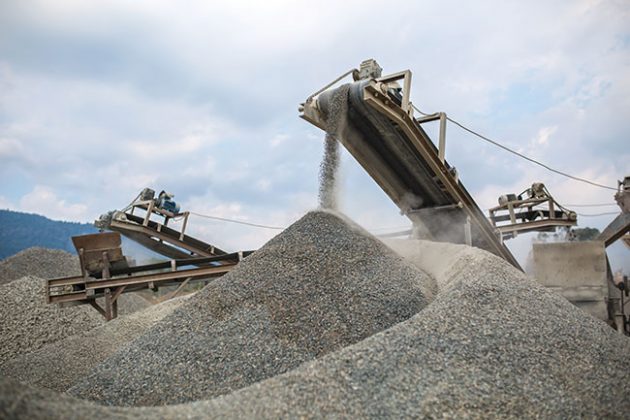
Features
Education
Aggregates
A mixed bag of outlooks after uncertain 2020
Outlooks all over the map after an uncertain 2020
February 12, 2021 By Grant cameron
 Photo credit: © catwalkphotos / Adobe Stock.
Photo credit: © catwalkphotos / Adobe Stock. After a year of uncertainty caused by COVID-19, roadbuilding contractors and aggregate producers across the country have a very mixed bag of opinions about what’s in store for their jurisdictions in 2021. As they look into the crystal ball, some are expressing optimism about the year ahead while others fear there will be a slowdown as municipalities use funds earmarked for capital projects to cover operating deficits.
In Ontario, tenders are down and hundreds of construction workers have already been laid off. Up to 41,000 construction-related jobs are at risk if building permits continue to decline, according to a report produced for Residential and Civil Construction Alliance of Ontario by Prism Economics and Analysis.
In the Prairie provinces, contractors in Saskatchewan and Manitoba are expecting decent years but those in Alberta aren’t sure what the future holds because a lot of money that was earmarked for capital projects over three years was spent in spring 2020 to offset the effects of the COVID-19 slowdown.
The industry in Quebec has a number of projects on the go which will provide stability but a slowdown is expected for the roads and infrastructure subsectors due to reduced investments by the municipalities.
In the Maritimes, New Brunswick is expecting a decent year in 2021, as the province’s capital budget is in line with the one in 2020, while in British Columbia there are many projects underway or slated to get going as the province is investing heavily to improve highways and bridges and forest service roads.
Nationwide, there are some very large projects that have been given the green light or are under way. The latest progress report from the Canada Infrastructure Bank shows the Crown corporation has invested in 10 projects across the country, including $1.28 billion for the $6.3-billion Réseau express métropolitain (REM) light rail transit project in Montreal, and up to $2 billion for the Go Expansion – On Corridor project to build and expand infrastructure for more frequent service between Toronto and Hamilton. Housing starts are trending upwards but Canada Mortgage and Housing Corporation has reported there’s a moderate degree of vulnerability. Labour shortages, meanwhile, continue to be a concern, especially in Ontario where truck drivers in the aggregate industry are in short supply.
Ontario
In Ontario, producers are anticipating a slight decline in volume of aggregate extraction as a result of fallout from COVID-19 and there are concerns by roadbuilders that municipalities might have to cover operating deficits.
“Obtaining as much transparent insight as possible into capital program pipelines for the upcoming year is more important now than ever before,” notes Andrew Hurd, director of policy and stakeholder relations at the Ontario Road Builders’ Association (ORBA). “The November 5 provincial budget indicated stable funding forecasts for highway, bridge and transit infrastructure over the next three years.”
The provincial Ministry of Transportation has also provided early notice of a strong projected first quarter tendering program, which hopefully bodes well for future quarters, he says.
“Our members are monitoring the municipal situation closely – the concern has been that municipalities with extensive transit systems, around GTHA especially, might be forced to shift capital program funding to cover operating deficits. The recent announcement that Phase 2 funding is now flowing to municipalities under the Safe Restart Agreement is certainly welcome news,” he says.
Hurd says that Infrastructure Ontario has also introduced a new rapid procurement and delivery category with a focus on health infrastructure. RFQs for work on Highway 3 and Highway 17, meantime, are expected and contracts for the Ontario subway line in Toronto are expected to be awarded in 2022.
Norm Cheesman, executive director of the Ontario Stone, Sand and Gravel Association (OSSGA), says the tendering process slowed in 2020 for future jobs so there are not as many projects in the pipeline, which will result in a decline in demand for aggregate.
“Countering this, of course, is the infrastructure projects that all levels of government are promising. The key is how many shovel-ready contracts can be signed, but once they are, I am confident that the full supply chain from raw material to finished product will meet the demand,” he says.
Cheesman says it will be interesting to see what happens to new housing starts over the next couple of years as one of the unintended consequences of COVID has been reduced immigration.
“In 2019, Ontario welcomed just over 135,000 immigrants – all needing housing. I am guessing, but we may not reach that number again for a couple of years. Obviously this is a temporary problem, but there is bound to be a ripple effect throughout the economy and ultimately our industry,” he says.
The biggest challenge facing the industry is close-to-market supply of aggregate, he says. OSSGA has been working to change rules that essentially stop any new aggregate extraction in the habitat of new or endangered species within the Natural Heritage System of the Growth Plan for the Greater Golden Horseshoe.
“While at first read that may sound reasonable – the effect will be to shut down any new aggregate development, creating a supply problem which will not become apparent for a few years down the road. The better solution would be to allow new extraction, but subject to the full force of the Endangered Species Act,” Cheesman says.
Prairies
Among the Prairie provinces, the outlook for Saskatchewan and Manitoba appears promising but the jury is still out in Alberta.
“We will see increased work on the market in 2021 so the industry is gearing up for a positive year,” says Shantel Lipp, president of the Saskatchewan Heavy Construction Association (SHCA). “This is thanks to a great deal of stimulus work currently being tendered for construction throughout 2021 and 2022. Saskatchewan also has some major irrigation projects coming out over the next several years that should also deliver an added boost to the industry.”
Contractors involved in the earthmoving sector are still struggling a bit, she notes, but the SHCA is anticipating a greater amount of paving and re-surfacing work coming from the Ministry of Highways. Many rural municipalities have received stimulus funding which will be allocated for rural roads and bridges.
Chris Lorenc, president of the Manitoba Heavy Construction Association, says 2021 should be a better year for the industry.
“I’m optimistic that budgets for infrastructure will hold whether they’re at the provincial or municipal level. We’re hoping for the influx of federal funding, so I would say that overall I’m cautiously optimistic,” he says.
Lorenc is hoping that the Lake Manitoba and Lake St. Martin Outlet Channels project is approved. The massive venture is aimed at enhancing the existing flood mitigation infrastructure to protect communities. The province has released its tender schedule for 2021 but 40 per cent of projects are RFPs, which is not actual work, he notes.
John Ashton, executive director of the Alberta Sand and Gravel Association, says the outlook for 2021 is very uncertain. Last year was tough due to
COVID-19 and heavy spring rains that delayed work, but because provincial stimulus money flowed to municipalities it went from being a disaster to just a normally bad one, he says.
The funding was not new money, though, and was part of a three-year capital budget plan. Because it was advanced for use in the first year as a response to COVID-19, contractors aren’t sure what’s in store down the road and will be eagerly awaiting the province’s budget expected in February.

In the Prairie provinces, contractors in Saskatchewan and Manitoba are expecting decent years; but those in Alberta aren’t sure what the future holds.
Photo credit: © EUGENI_FOTO / Adobe Stock.
Quebec
Gisèle Bourque, CEO of the Quebec Road Builders and Heavy Construction Association, known as the ACRGTQ in French, says the industry is expected to remain stable but a slowdown is anticipated for the roads and infrastructure sub-sectors. On the other hand, major projects will continue in 2021, including the construction of the REM and the repair of the Ville-Marie and Viger tunnels in Montreal, and redevelopment of Route 185 in Bas-Saint-Laurent.
Bourque notes that the Quebec National Assembly adopted Bill 66 which will accelerate infrastructure projects in hopes of boosting the economy.
“The ACRGTQ welcomed this bill positively and considers that this economic recovery can and must be carried out in accordance with the rules of integrity of public contracts,” she states. “Many infrastructure projects will be moved ahead in time and put in place quickly to stimulate the economy.”
Bourque says it is essential to remember that the projects related to investments in public infrastructure bring significant benefits for all economies and players in the construction industry.
British Columbia
In B.C., many highway infrastructure upgrade projects are underway, especially in the northern part of the province. Roughly $28 million is earmarked under B.C.’s Economic Recovery Plan to upgrade side, secondary and forest service roads as part of $418 million allocated to revitalize community infrastructure and boost the economy.
About $20 million is being used under the Remote and Rural Communities program to fund more than 80 shovel-ready projects that will make getting around easier, including local paving and shoulder-widening. To date, 31 of the more than 80 planned projects are complete, and 37 more are underway. Another $8 million is going to fund 75 projects to help upgrade forest service roads in various rural locations.
Numerous improvements to highways and bridges throughout northern B.C. are also underway, including the new four-lane, $1.4-billion Pattullo Bridge replacement, linking New Westminster and Surrey.
Many highway infrastructure upgrade projects are also occurring throughout the Lower Mainland and new flood-mitigation infrastructure is being built in the Peace River region in the northeast part of the province.
Meantime, work continues on realignment of more than 30 kilometres of Highway 29 and building new bridges between Fort St. John and Hudson Hope as part of the Site C project.
Atlantic Canada
There are plenty of road and highway infrastructure projects on tap for Atlantic Canada in 2021.
Tom McGinn, executive director of the New Brunswick Road Builders and Heavy Construction Association, says when COVID hit, the industry wasn’t sure how tenders would roll out, but they were steady.
“It ended up being not too bad,” he says. “Everyone seemed to have a good summer. COVID did increase costs, but for the most part are being covered by government.”
McGinn expects a decent year as spending outlined in the capital budget is in line with 2020 and big changes are anticipated.
Stability is important for the industry and contractors will continue to lobby for multi-year capital budgets with stable funding.
In Nova Scotia, work will continue in 2021 on one of the largest and most expensive infrastructure projects in the history of the province, a $718-million twinning of Highway 104 from Sutherlands River east of New Glasgow to Antigonish.
The project will take close to three years to complete and entails building 28 kilometres of new two-lane twinned highway and 10 kilometres of new four-lane twinned highway. There are two interchanges and 24 new bridges planned along the route which is part of the Trans-Canada Highway.
Dexter Nova Alliance, led by local contractors Dexter Construction and Nova Construction, with BBGI as an equity partner, won the bid for the project last May after an extensive procurement and bidding process.
Ken MacLean, vice-president of Dexter Nova Alliance, says he is pleased that the long-anticipated project is under way.
“This is a significant project that will have a positive impact on our province for decades to come. It will be built by Nova Scotia-based companies for Nova Scotians and we are proud of that,” MacLean says.
In Newfoundland and Labrador, more than $165 million is being invested in provincial highways and bridges, including $39.8 million for the Trans-Labrador Highway. Another $200,000 is earmarked for a pre-feasibility study for a road to the north, which could potentially link northern communities to the rest of Labrador.
The Department of Transportation and Infrastructure sought public input for road work projects to add to its five-year plan and will be publishing a new list of road work projects ahead of the 2021-22 construction season.
In Prince Edward Island, work continues on four projects that entail resurfacing 270 kilometres of the province’s national highway system over four years and replacement of 18 bridges. The federal government has invested more than $101 million in the roadway projects and P.E.I. is contributing more than $114 million.

Labour shortages continue to be a concern. Especially in Ontario, where truck drivers in the aggregate industry are in short
supply. Photo credit: © catwalkphotos / Adobe Stock.
NWT
In the Northwest Territories, construction will resume in spring on the $411.8-million Tlicho All-Season Road, a 97-kilometre-long, gravel thoroughfare that will connect the community of Whati with Yellowknife Highway which runs around Great Slave Lake to the territory’s capital.
Right-of-way clearing has been completed, embankments have been constructed and three of four bridges are completed. The road is expected to open to the public in the fall.
Construction is also expected to start this year on a 13-kilometre stretch of two-lane, gravel road that will wind its way from Canyon Creek near Ten Mile Island south to Prohibition Creek. It will replace a winter road that has to be built annually and be a crucial piece of the eventual Mackenzie Valley Highway.
Nunavut
In Nunavut, the Kitikmeot Inuit Association wants to re-start the environmental assessment process that was shelved two years ago for a 227-kilometre-long, all-season gravel road that would connect a mineral-rich region in the NWT to a deep-water port and Arctic shipping stop at Grays Bay. The project has been revived after the federal government provided a $21.5-million infusion for the process to continue.
The road would link the Northwest Passage with year-round access to the interior of the Slave Geological Province, an area that straddles the boundary of Nunavut and the NWT, including a number of working diamond mines.
Yukon
The Yukon government has signed agreements with several First Nations communities to proceed with upgrades to the Freegold Road, Nahanni Range Road and parts of the Robert Campbell Highway and North Canol Road. However, none of the work has started and the Yukon Chamber of Mines is worried that the funding will dry up, if not used.
Three years ago, Yukon Premier Sandy Silver and Prime Minister Justin Trudeau jointly pledged just over $360 million in funding to build and upgrade mining roads, and mining companies promised another $108 million as part of the Yukon Resource Gateway Project to provide more reliable access to mineral-rich areas with proposed upgrades to about 650 kilometres of existing resources roads in the Dawson and Nahanni ranges.
Print this page